Shortly after the close of World War II, two Christmas classics were released just six months apart. It’s a Wonderful Life (Dec. 1946) and Miracle on 34th Street (May 1947) have both found a place as feel-good Christmas classics, still shown 60 years later to children that grew up on them. Likely because of their close proximity to the good feelings of VJ day and the return of so many soldiers, both are firmly placed as Christmas staples. In addition to their close release and Christmas theme, the two share certain plot elements as well. Both films take place firmly in the world of business and commerce, with the Baily Brother’s Building and Loan and Macy’s Department Store supplying the bulk of the setting. Both stories share a central conflict of a decent man facing wrongful imprisonment and a triumphant ending that rights the wrong.
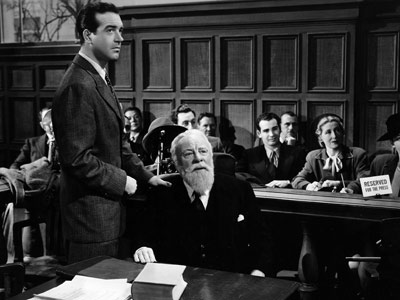
Because of the centrality of capitalism and justice to the plot, both films have a lot to say about the American dream and the values of democracy and capitalism. While both Miracle and Wonderful Life tell an ultimately uplifting tale, the two films have diametrically opposite statements about the relationship between moral people and moral institutions.
It’s a Wonderful Life is deeply cynical about the institutions that dominate American life. Capitalism gets it the worst – the defining characteristic of the villainous Potter is that he’s a banker. He is greedy and horrible, the embodiment of everything that wrong with a capitalist society. He is practically cartoonish in his villainy, with a skull on his desk, an evil cackle and a mute body-servant.
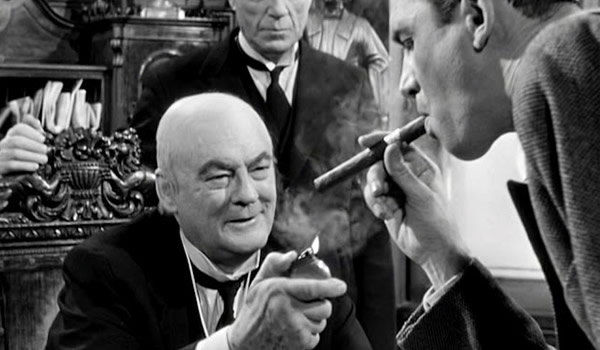
But Potter isn’t the only enemy – capitalism itself does its level best to destroy George Bailey. We’re shown repeatedly that George is the best and brightest of his generation, but the dire economic circumstances of his family and his town prevent him from doing anything more than getting by. Capitalism is supposedly a meritocracy, but George’s life is dominated by harsh economic reality.
From a philosophical standpoint, capitalism is generally justified by the argument that we’re all better off if everyone acts in his or her own rational self-interest. Bailey Bros. Building and Loan, we’re told again and again, is the antithesis of this idea – George runs the S&L not to make a profit but for the benefit of the town. We’re shown quite explicitly that his selflessness is literally the only thing standing between the town of Bedford Falls and ruin.
Government is treated little better. While the government employees of Bedford Falls are not really against George Bailey, the government itself is utterly beholden to the moneyed interest. Despite being George’s friend, the prosecutor is (mostly) powerless against the need to arrest George if he can’t come up with the missing money. The bank inspector is a family man but is still portrayed as the worst sort of bureaucrat, completely captured by a system that demands obedience. In the world of Wonderful Life government is, at best, not actively out to destroy the little guy, but largely powerless to help.
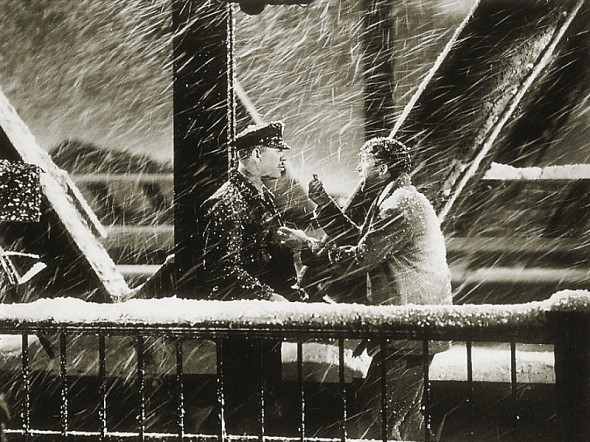
Pictured: The Government, not helping
If you don’t believe my interpretation of the movie, listen to the FBI, circa 1947:
“With regard to the picture “It’s a Wonderful Life”, [redacted] stated in substance that the film represented rather obvious attempts to discredit bankers by casting Lionel Barrymore as a ‘scrooge-type’ so that he would be the most hated man in the picture. This, according to these sources, is a common trick used by Communists. [In] addition, [redacted] stated that, in his opinion, this picture deliberately maligned the upper class, attempting to show the people who had money were mean and despicable characters.”
But of course, while it is at times a deeply sad movie, It’s a Wonderful Life is ultimately a triumph. In contrast to the dehumanizing and degrading institutions that dominate Bedford Falls, the people are generally decent, kind and generous. George Bailey is kept out of prison despite the government and despite the evil banker. The people of Bedford Falls turn out to help their friend George with money when he needs it. At the end, the prosecutor (George’s friend) tears up the warrant for George’s arrest, likely in violation of the law (you can’t get out of embezzlement charges just by putting the money back later). The central message of Wonderful Life is that the right result is achieved because the people are good, despite flawed institutions.
In Miracle on 34th Street, this relationship is flipped on its head. In Miracle, good institutions succeed despite the base motives of the individuals that participate in them. The judge that presides over the trial is the worst sort of politician-judge, literally looking over to his crony advisor for advice in the middle of a trial. He’s not a bad man but the judge is clearly far more interested in his own political advancement than he is making an accurate or fair decision. Whether or not Kris Kringle deserves to be committed is quite beside the point. In the end, though, he makes the right decision because of public pressure – the elected judiciary works.
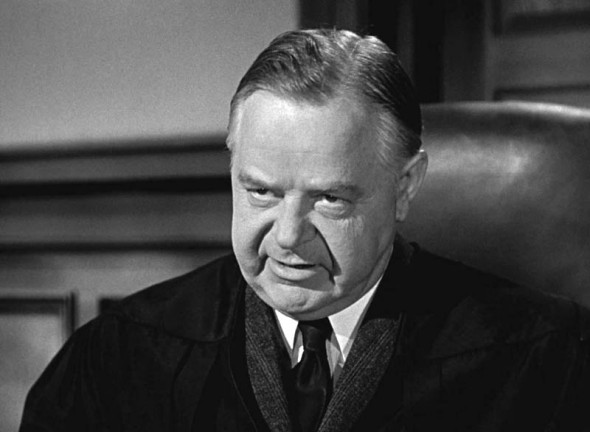
Like government, capitalism is portrayed as the great leveler. When Kris creates the a new “marketing scheme” of sending customers to the right store, Macy’s and Gimbals start a race-to-the-bottom in an effort to serve their customers (and, not coincidentally, boost profits!) The goals of serving customers better and profiting more are portrayed as one and the same. This isn’t subtext – the boardroom meetings at Macy’s and Gimbals quite explicitly portray the companies as being solely interested in profit, while at the same time showing that the consumer benefits. Again, the goals of the system are achieved despite the motives of the people that work in them.
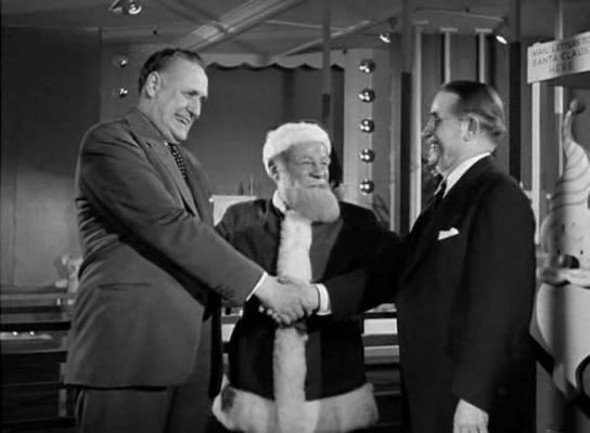
With the exception of Kris Kringle (who we’re led to believe is magical), nearly every adult in the film is at least partially selfish. Even Fred Gailey, the lawyer who represents Kris pro bono, realizes that his defense of the man aligns with his interest in building a new practice (and getting in good graces with his attractive neighbor). The crucial mail-bag evidence arrives at the court house essentially because the post office workers figure out a way to make a pile of mail someone else’s problem. 34th Street’s message is an inversion of Wonderful Life – people are the problem, but well-designed institutions can thrive despite them.
So why the difference? Why is one movie the product of a communist plot to destroy America and the other, released just 6 months later, is essentially just a long advertisement for democracy, brought to you by Macy’s? A look at the production history reveals an important difference – while it was filmed after World War II, the story Wonderful Life is based on was written in 1939. Wonderful Life’s heart and soul comes from the depths of the Depression.
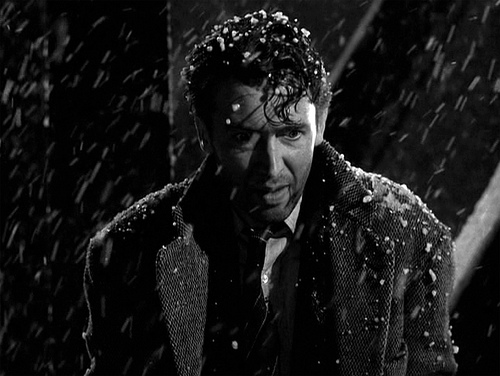
During the Depression, institutions had failed. Unbridled capitalism had led to ruin, and seemingly everyone everywhere was suffering. Despite FDR and the New Deal’s best efforts, government was in many ways powerless to stop it. People had to count on one another to get by, and Wonderful Life reflects that – when George is down and out, the people of Bedford Falls rally together to save him. The Depression was an institutional failure, not a personal failure.
World War II saw untold horrors unleashed on the world. While governments and institutions were responsible for those horrors, governments and institutions were equally responsible for putting a stop to those horrors. Good people banding together to help out a nice guy won’t help you when the Nazi’s or Empire of Japan are knocking at your door. The Germans and Japanese weren’t evil people – they just had bad institutions, and we had good ones. The 40s were defined by a struggle between three opposing systems– Fascism, Communism and Democracy/Capitalism.
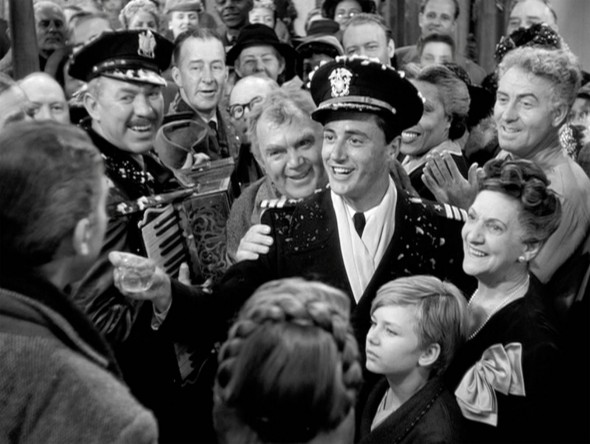
The only pro-government aspect of Wonderful Life comes at the very end, in the person of CDR Harry Bailey and his Medal of Honor. I haven’t read the original short story, but given that it was written in 1939 I’m quite certain it didn’t involve a WWII fighter ace shooting down a kamikaze. The war changed the story. That scene and Miracle on 34th Street are the product of a long decade of war that saw the triumph of one way of life over another, the product of a society freshly victorious over one system and staring down a conflict with another. We could no longer afford to count on people being good – Communists were thought to be lurking around every corner. Only good institutions that would work regardless of the people that worked in them would serve to win in a war of ideologies.
The best governments and institutions are designed to take into account the baser motives of man. But no government can function without at least some altruism, without communities being willing to band together and help out the little guy. As always, the truth about people is probably somewhere in the middle – people aren’t all good or all bad.
With all of that said, I love both movies. I watch both movies every year, and usually get choked up at the end of It’s a Wonderful Life, even though I know almost every line by heart. Both movies work because they tell us a story that we want to hear, that we want to be true – we want to believe that our neighbors will help us out in a jam, that friendship really is more important than money. But when it comes down to it, we also want a government that doesn’t need that story to be true.
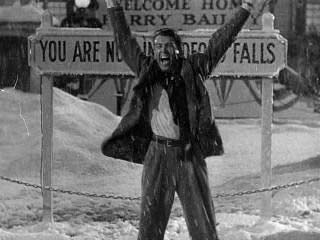
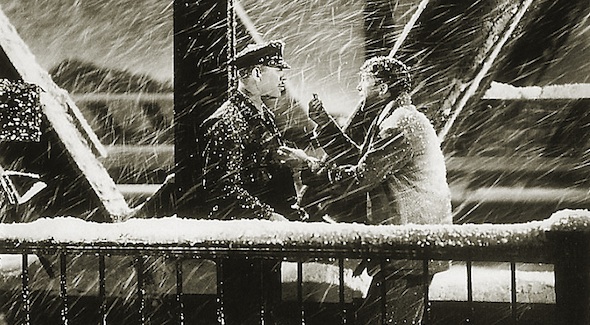
I just finished watching It’s a Wonderful Life and headed over here to see if there were any articles about it, and sure enough this was on the front page. Awesome. :D
We were watching it in my economics class (except I finished it at home because I’m sick…bleh); this movie has so many different levels if you analyze it from an economical or historical standpoint, rather than as a nice Jimmy Stewart movie.
Actually, the popularity of “It’s a Wonderful Life” has nothing to do with WWII. It didn’t become a culturally significant Christmas movie until the 1970s, and before then it was a forgotten box office flop.
TV stations in the 1970s started airing it to fill dead air time around Christmas, as its copyright had expired (*sort of). The studio that owned the movie didn’t think it was worth the price of filing paperwork for a renewal. Thus, it was a cheap for networks to air. Sheer saturation brought it to wider attention and acclaim.
* The short story it was based on hadn’t expired, so royalties still needed to be paid toward that by TV stations. However, early on the movie was obscure, and the royalties only became an issue when there was money to be made off the now-popular movie.
Great article, though I must say that the great revelation in it for me is that Miracle on 34th Street was released in May! I know there was a much longer tail on screenings in those days, but that just seems ridiculous.
I’ve always believed that George is in a mental institution hallucinating his “happy ending” in It’s A Wonderful Life having cracked from his arrest and the failure of his actually “unhappy reality”. Kris Kringle in Miracle isn’t actually Santa Claus…..he’s a slightly eccentric rich guy who owns stock in Macy’s and never goes to stockholders’ meetings so the board doesn’t recognize him. Gimbell’s sales were killing that year and Macy’s was in the red meaning Kris Kringle’s stock was going to wind up in the sh*tter. Dressing up as Santa Claus and playing “secret shopper” at Macy’s was simply a way to find out why Gimbell’s was beating them out of the market place and try and pull that years revenues up. He went along with the trial because he knew it would generate a lot of buzz about Macy’s. Kris’s real family and lawyers and staff could easily pop out of the woodwork and “save” him from incarceration if he lost. The house at the end was payment for the lawyer’s representation as he was actually rich enough not to need one pro bono.
Marvel > DC,
Do you have a blog? Your comment has me wanting to read more.